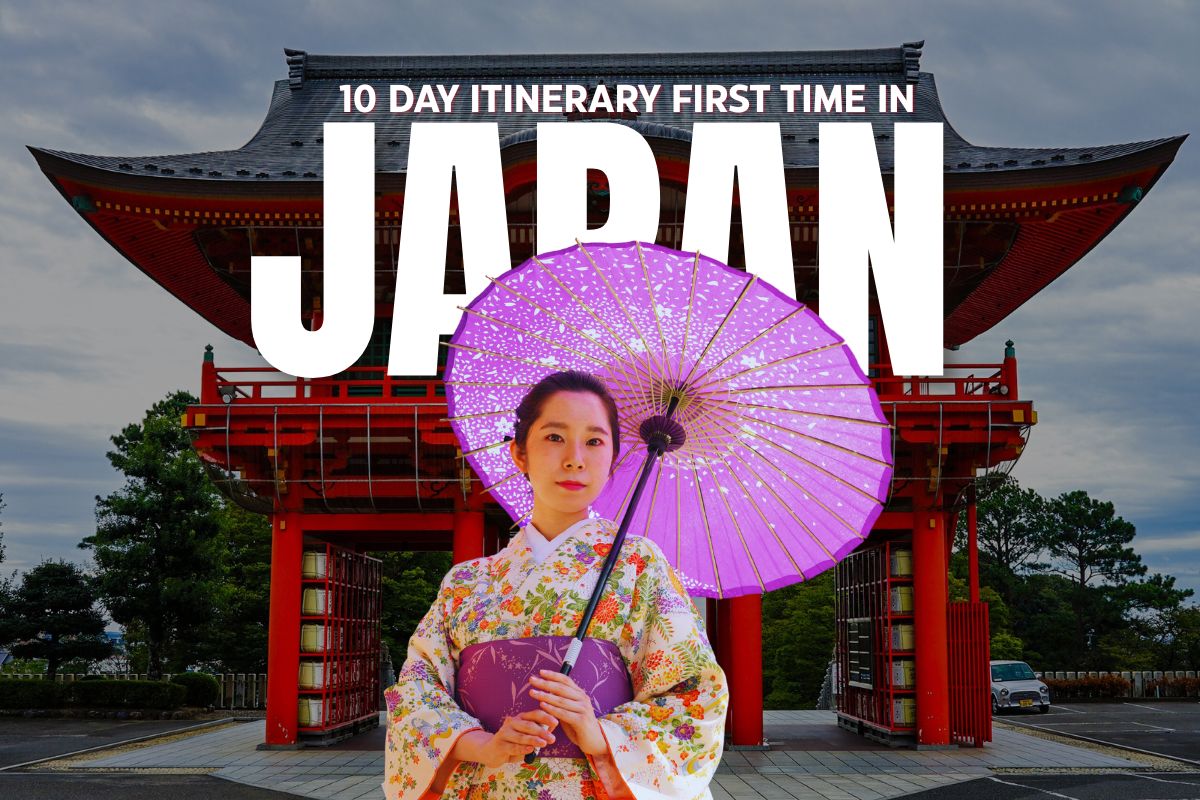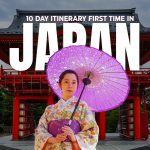So you’re thinking about Japan? Smart choice. This country will mess with your head in the best possible way. Ancient temples sit next to vending machines that sell hot coffee. Monks chant while salary workers rush past on their phones. A 10-day itinerary first time in Japan lets you see the main stuff without going nuts trying to fit everything in.
Days 1-3: Tokyo: Where Chaos Makes Sense
Land at Narita or Haneda. The train into the city costs about 3,000 yen. Don’t stress about the subway system; it looks scary, but it works better than anything back home.
Day one: Hit Shibuya Crossing. Yeah, it’s touristy. Do it anyway. The organized chaos is wild. Grab lunch at a tiny ramen shop. The best ones have lines and no English menus. Point at what someone else is eating.
Meiji Shrine sits right in the middle of all that madness. Free to enter. The contrast will blow your mind as you go from neon and noise to total quiet in about five minutes.
Day two takes you to Asakusa. Senso-ji Temple is old. Really old. Like, 1,400 years old. The street leading up to it sells everything from plastic ninja swords to actual handmade crafts. Buy the weird Kit Kat flavors. Trust me.
Afternoon: Akihabara. This place is bonkers. Electronics everywhere, anime characters on every surface, and more LED lights than Las Vegas. Even if you’re not into tech stuff, it’s worth seeing what peak Japanese weirdness looks like.
Day three: Wake up early for the Tsukiji Outer Market. Get there by 8 AM or earlier. The sushi breakfast will ruin every other sushi place for you forever. Fair warning.
Imperial Palace East Gardens after lunch. Pretty, peaceful, and the complete opposite of everything else you’ve seen so far. End in Ginza if you want to see how the rich half lives.
Days 4-5: Mount Fuji Area: The Postcard Mountain
Mount Fuji hides behind clouds about 70% of the time. Check the weather forecast. Clear days mean good photos. Cloudy days mean you’ll stare at gray sky and wonder why you came.
Lake Kawaguchi gives you the classic Fuji view. Rent a bike and ride around the lake. Takes about three hours. Stop at random spots for photos.
Sleep in a ryokan in Hakone. Yes, they’re expensive. Yes, it’s worth it. The hot spring baths are separate for men and women. You soak naked. Get over it. This is Japan.
Days 6-8: Kyoto: Where Old Japan Lives
The bullet train from Tokyo to Kyoto takes 2 hours and 15 minutes. Costs 13,320 yen if you buy individual tickets. The JR Pass makes this math work in your favor.
The bullet train between Tokyo and Kyoto is 2 hours and 15 minutes in each direction. Costs 13,320 yen if you purchase individual tickets. The JR Pass is the product that makes these numbers work in your favor.
Kyoto counts 1,600 Buddhist temples and 400 Shinto shrines. You can’t see them all. Don’t try. Choose some good ones — and enjoy them, rather than racing with your phone in hand. Golden Pavilion (Kinkaku-ji). It’s safe to say that Golden Pavilion is surely one of the more photographed edifices in Japan. Post to Instagram every few seconds. Still worth seeing because it’s genuinely beautiful.
Go early to beat the crowds. Fushimi Inari Shrine has 10,000 red gates going up a mountain. Takes about 2-3 hours to hike the whole thing. Most people quit halfway up. Push through, as the views from the top are better and way less crowded.
There are wooden buildings, close quarters, and possibly a chance to spot a geisha. Maybe. This is Kyoto, where they’re called geiko, not geisha. Don’t chase them with cameras. And that is rude, and you will look like a moron.
Arashiyama bamboo grove: a forest of tall bamboo forms natural green tunnels. It jingles like a wind chime while in motion. Fills up at 10 a.m., so be early or late.
Days 9-10: Nara and Osaka: Ancient Capital Meets Food Heaven
Nara day trip: 1,200 deer roam free in Nara Park. They bow for crackers. Seriously. Buy the special deer cookies (200 yen) and watch them bow before they eat. Don’t feed them anything else, as it makes them sick.
Todai-ji Temple: houses a bronze Buddha that’s 50 feet tall. The building is massive. Makes you feel small in a good way.
Last day: Osaka. The food scene here is intense. Dotonbori Street at night looks like Tokyo’s crazy cousin. Neon signs shaped like giant crabs and fish. Try takoyaki (octopus balls) from a street cart. Weird texture, great taste.
Osaka Castle: rebuilt after WWII bombing, still impressive. Good city views from the 8th floor. Skip it if you’re castled out from other places.
Getting Around Without Going Broke
JR Pass prices: 7-day pass costs 50,000 yen, 14-day pass costs 80,000 yen. Do the math. Tokyo to Kyoto round trip alone costs 26,640 yen. Add a few local trips, and the pass pays for itself.
Buy the pass before you get to Japan. Can’t get it there. This rule is firm.
Local trains, subways, and buses all work differently. Google Maps actually works great in Japan for transit directions. Download it offline just in case.
Money Stuff
Cash rules everything. Credit cards work at big places, but that tiny ramen shop only takes cash. 7-Eleven ATMs work with foreign cards. Withdraw more than you think you need.
No tipping. Ever. Trying to tip confuses people and sometimes offends them. The service charge is built into prices already.
Budget around $120-160 per day total. That covers food, transport, activities, and a decent place to sleep.
Where to Sleep
Business hotels are clean, small, and perfect for sleeping. Around $90-130 per night. Capsule hotels cost less but feel like sleeping in a spaceship. Fun once, maybe not for a week.
Stay near train stations. Shibuya, Shinjuku, and Tokyo Station areas keep you connected. Walking 10 minutes to the station every morning gets old fast.
Food Real Talk
Convenience store food is legit good. 7-Eleven chicken karaage beats most restaurant versions. Onigiri (rice balls) make cheap, filling snacks.
Department store basements have food courts that shame American mall food. High quality, reasonable prices. Look for the basement level in any big department store.
Ramen shops have vending machines for ordering. Push buttons, get tickets, and give tickets to the cook. No Japanese required.
Final Thoughts
A 10 day itinerary first time in Japan works because it gives you time to slow down between the major hits. You’ll see Tokyo’s craziness, Kyoto’s history, and Osaka’s food scene without feeling like you’re running a marathon.
Book hotels early if you’re going during cherry blossom season (March-May) or fall colors (October-November). These times are beautiful, but everyone knows it.
Japan will surprise you. Things that should be complicated work smoothly. Things that should be simple get weird. People follow rules religiously but bend over backwards to help strangers. Your first trip won’t be your last, as Japan gets under your skin.











